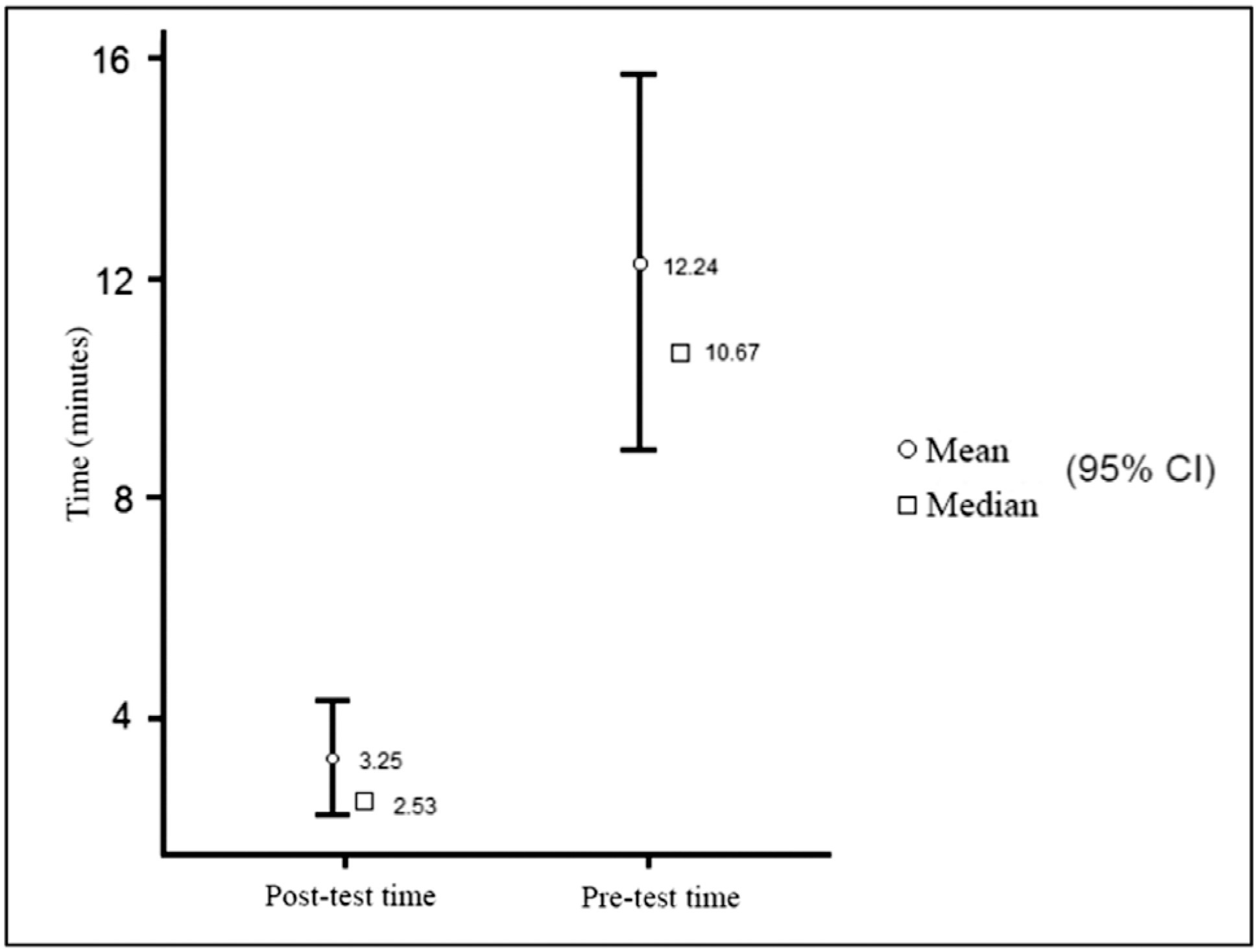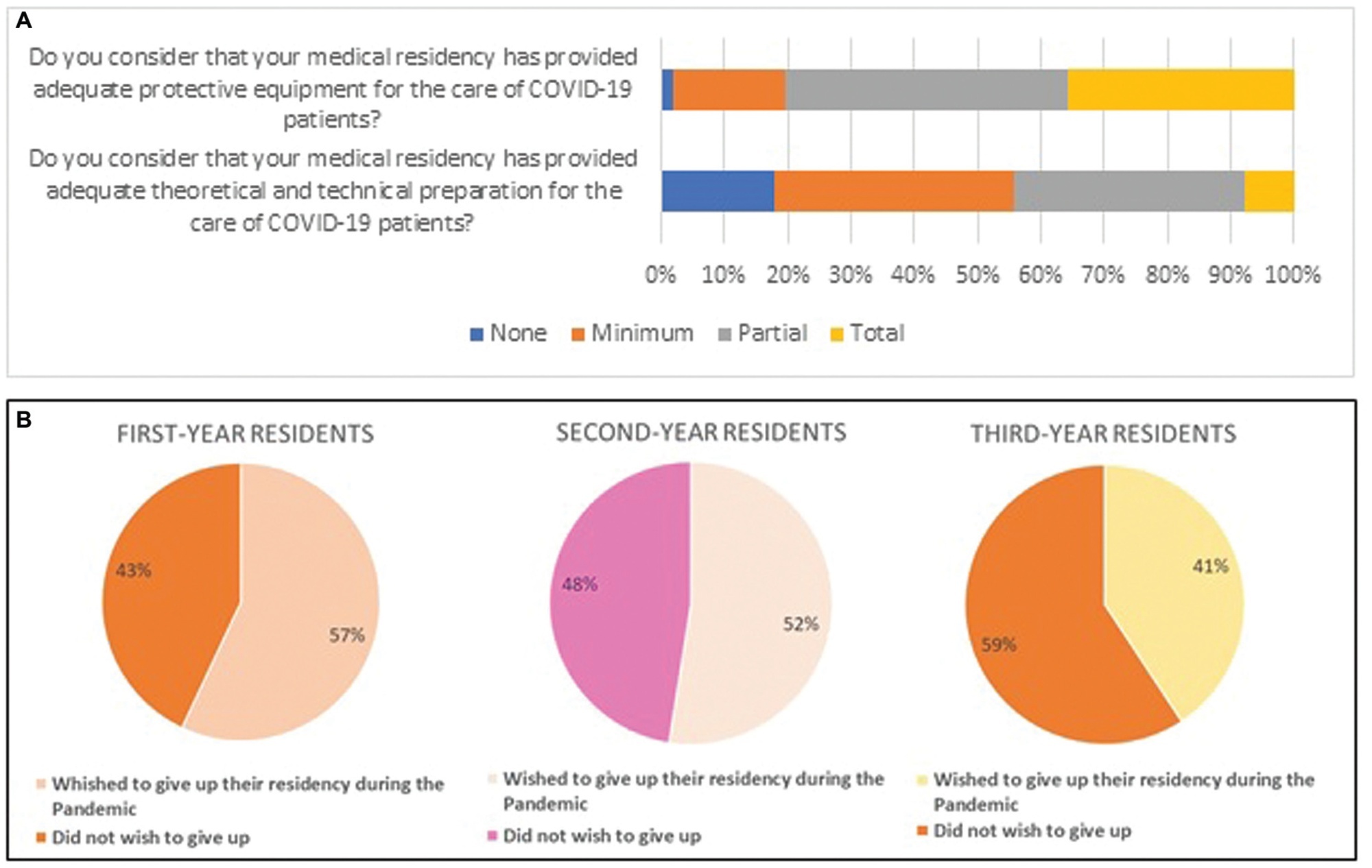Summary
Revista Brasileira de Ginecologia e Obstetrícia. 2023;45(10):603-608
12-11-2023
To evaluate the performance of residents in gynecology and obstetrics before and after practicing laparoscopic sutures, to establish when the training shows the best results, in addition to comparing whether being in different years of residency influences this progression.
A prospective cohort study involving 32 medical residents evaluated with a pretest to establish their previous knowledge in laparoscopic suture. This test consisted of knotting two wires, one made of polypropylene and the other of polyglactin, with a blocking sequence of five semi-knots. We set a 30-minute limit to complete the task. Then, the residents held four training meetings, focusing on suture, Gladiator rule, knot, and symmetries, in addition to executing blocking sequences. A second test to establish progress was performed.
Regarding the time spent to make the stiches using polyglactin wire, a statistically significant time improvement (p< 0.01) was observed, with a 10.67-minute pretraining median (mean 12.24 minutes) and a 2.53-minute posttraining median (mean 3.25 minutes). Regarding the stitches with polypropylene wire, a statistically significant time improvement (p< 0.05) was also observed, with a 9.38-minute pretraining median (mean 15.43 minutes) and a 3.65-minute posttraining median (mean 4.54 minutes). A total of 64.2% of the residents had been able to make the knot with polypropylene previously. One hundred percent were able to complete the task in the posttest.
Model training using the Gladiator rule for laparoscopic suture improves the knotting time with statistically similar performance, regardless of the year of residency, after systematic training.

Summary
Revista Brasileira de Ginecologia e Obstetrícia. 2023;45(7):377-383
09-08-2023
To analyze the impact of the COVID-19 pandemic on the residency of gynecology and obstetrics in São Paulo.
Cross-sectional study developed by representatives of residents of the Association of Gynecology and Obstetrics of the State of São Paulo (SOGESP, in the Portuguese acronym). Data were collected from questionnaires applied to gynecology and obstetrics residents registered on the SOGESP website in February 2022. The interviewees answered about the repercussions of the pandemic on medical residency and whether they had technical and psychological support during the period.
A total of 247 questionnaires were collected from residents of gynecology and obstetrics. The residents had an age of 28.3 ± 3 years old, and most of them were female (88.4%). The displacement to COVID care was reported by 62.34% of the students, but only 35.6% reported completely adequate personal protective equipment and only 7.7% reported complete theoretical and technical instruction to support these patients. Almost all of the interviewees stated that the gynecology sector was the most affected. The majority of the interviewees considered that the second-year residents had the greatest loss, and more than half of the residents in the 1st and 2nd year said they wished to give up their residency during the pandemic. More than 80% of the residents reported online theoretical classes and/or presentation of articles, reinforcing the fact that virtual activities gained a greater space within the medical residency.
The pandemic impacted the residency in greater proportion in outpatient clinics and gynecological surgeries, also interfering with the physician's desire to continue with the program.

Summary
Revista Brasileira de Ginecologia e Obstetrícia. 2022;44(6):621-628
08-15-2022
Breaking bad news is common in obstetrics and gynecology (ob-gyn). However, it is difficult, and few doctors receive training on how to deal with this situation. This narrative review aims to gather, analyze, and synthesize part of the knowledge on the area, focused on Ob-Gyn. Among the 16 selected articles, two are randomized controlled intervention studies, and most studies refer to obstetrics. The results found by us pointed out that simulation, feedback/debriefing, lectures, and protocols could improve doctors’ performance in communicating bad news. For patients, the context and how the information is transmitted seem to impact more than the content of the news. Ob-Gyn doctors could benefit from specific protocols and education, given the specialty’s particularities. There is a lack of evidence about the most effective way to conduct such training. Finding validated ways to quantify and classify studies’ results in the area, which would allow for the objective analysis of outcomes, is one of the biggest challenges concerning this topic.
Summary
Revista Brasileira de Ginecologia e Obstetrícia. 2021;43(8):622-626
11-15-2021
To analyze the effect of the One-minute Preceptor model for preceptors who work at the emergency department of a maternity teaching hospital.
A quantitative intervention study conducted with Obstetrics and Gynecology residency preceptors at amaternity teaching hospital in northeastern Brazil. Three stages were performed: 1) a preintervention survey with the residents; 2) planning and execution of a pedagogical training course for the preceptors, which involved a lecture and a dramatization about the One-Minute Preceptor model; and 3) thirty days after the intervention, the residents answered another survey about the model and its repercussions and advantages.
The preintervention assessment with the residents showed that 91.7% agreed that there were discrepancies regarding the teaching model among the preceptors. After the training, all preceptors agreed that the model engages the student in the decision-making process, and that they would apply it to their routine. The postintervention results showed that 95.8% agreed that themodel ismore inviting than traditional teaching approaches. There was a perception of improvement in learning among 70.9% of the residents. In addition, the present study found a significant change in feedback before and after implementing the model, from 20.8% to 66.7%.
The training course of preceptors in the One-Minute Preceptor model proved to be efficient in providing formative feedback to residents in the emergency department of a maternity school. Further studies are needed to assess the consolidation of the methodology in the long term.
Summary
Revista Brasileira de Ginecologia e Obstetrícia. 2020;42(7):404-410
08-26-2020
To analyze the applicability and efficiency of amulti-approach laparoscopic training in improving basic laparoscopic skills of obstetrics and gynecology (OBGYN) residents.
Cross-sectional, observational and descriptive study, developed at the Experimentation and Surgery Training Center (CETEC, in the Portuguese acronym) of the Hospital Israelita Albert Einstein with OBGYN residents. Theoretical and practical tests were applied to 24 OBGYN residents to assess their laparoscopic skills before and after their participation in an 8-week course. The course involved theoretical lectures and practical laparoscopic surgery exercises developed using rubber models, black boxes, virtual simulators and animal models (pigs).
There was an overall improvement in the ability of the residents, with an increase in the number of correct answers in the theoretical evaluation and decrease in the time needed to perform practical tests (needle holder assembly and laparoscopic node). The course was evaluated by the students as highly relevant for both improving their surgical skills and motivating them to continue practicing.
Laparoscopic training using multiple approaches resulted in significant improvement of surgical skills with a high satisfaction level of the participants. Further studies are still needed to measure the long-term retention of these acquired skills.
Summary
Revista Brasileira de Ginecologia e Obstetrícia. 2019;41(2):97-101
02-01-2019
To analyze the prescription of antimicrobial agents for pregnant women admitted into the obstetrics service who presented with acute pyelonephritis.
Three cross-sectional studies were performed comparing the prescription of antimicrobials for pyelonephritis in pregnant women in the time periods evaluated (2010-2011: 99 patients evaluated; 2013: 116 patients evaluated; 2015: 107 patients evaluated), at the Hospital Fêmina, Porto Alegre, in the state of Rio Grande do Sul, Brazil. The analysis was performed before and after the promotion of an institutional protocol for the treatment of pyelonephritis during pregnancy, and on a third occasion after the introduction of a smartphone-based mobile educational tool.
The evaluation of the prescribing physicians and the adequacy of the prescriptions between the different periods studied revealed a significant increase in appropriate conduct for the choice of antimicrobial (2010: 83.8%; 2013: 95.7%; and 2015: 100%), route of administration (2010: 97%; 2013: 100%; and 2015: 100%), and interval (2010: 91.9%; 2013: 95.7%; and 2015: 100%), following the introduction of the protocol, and again after the implementation of the softwareapplicationwithorientationsontheantimicrobial treatment.
The use of specific mobile applications should be encouraged to attain a better quality and accuracy in prescriptions and to include strategies that not only reduce the risk of negative outcomes, but also improve the quality of care and treatment for maintaining the health both of the mother and of the baby.
Summary
Revista Brasileira de Ginecologia e Obstetrícia. 2018;40(10):599-605
10-01-2018
We have evaluated the prevalence of and the motivating factors behind the refusal to provide reproductive health services and the ethical knowledge of the subject among medical students from the Escola Bahiana de Medicina e Saúde Pública, in the state of Bahia, Brazil.
The present cross-sectional study involved 120 medical students. A questionnaire was utilized. The dependent variables were students’ objections (or not) regarding three clinical reproductive health cases: abortion provided by law, contraceptive guidance to an adolescent without parental consent, and prescription of emergency contraception. The independent variables were age, gender, religion, ethical value, degree of religiosity, and attendance at worship services. Ethical knowledge comprised an obligation to state the reasons for the objection, report possible alternatives, and referral to another professional. Data were analyzed with χ2 tests and t-tests with a significance level of 5%.
Abortion, contraception to adolescents, and emergency contraception were refused by 35.8%, 17.5%, and 5.8% of the students, respectively. High religiosity (p < 0.001) and higher attendance at worship services (p = 0.034) were predictors of refusing abortion. Refusal to provide contraception to adolescents was significantly higher among women than men (p = 0.037). Furthermore, 25% would not explain the reason for the refusal, 15% would not describe all the procedures used, and 25% would not refer the patient to another professional.
Abortion provided by law was the most objectionable situation. The motivating factors for this refusal were high commitment and religiosity. A reasonable portion of the students did not demonstrate ethical knowledge about the subject.
Summary
Revista Brasileira de Ginecologia e Obstetrícia. 2017;39(12):670-675
12-01-2017
To describe the experience of a distance education course on sexual issues during pregnancy and after birth for residents.
This prospective educational intervention study was conducted by investigators from the Universidade Federal de São Paulo, Brazil, between April and September 2014. The participants were 219 physicians (residents from the 1st to the 6th years). The duration of the course was of 24 hours (10 video lectures and online chats). At baseline, the participants answered questions about their training, attitude and experience regarding sexual issues during pregnancy and after birth; before and after the course, they answered questions to assess their knowledge about the topic; at the end of the course, they answered questions on the quality of the course. The Student t-test was used to compare the before and after scores of the knowledge tests; values of p < 0.05 were considered statistically significant.
A total of 143 residents concluded the course; most were in their 1st (27.2%) or 3rd (29.4%) years of residency. There was a significant increase in themean scores of the questionnaires that assessed the knowledge of the topic: 4.4 (1.6) versus 6.0 (1.3; maximum score: 10), before and after the course respectively (p < 0.0001). Most of the participants (74.1%) declared that the quality of the course as a whole reached their expectations, and 81.1% would recommend the course to a friend.
The online Sexology course for Obstetrics and Gynecology residents increased their knowledge about the sexual issues during pregnancy and after birth, and fulfilled the participants’ expectations. The experience described heremay serve as a model for other sexuality courses targeting similar audiences.